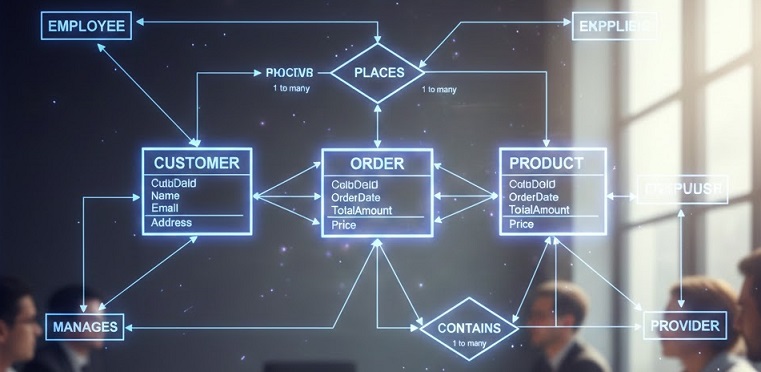What Are the Benefits of Entity-Relationship Diagrams
Entity-Relationship Diagrams (ERDs) offer a clear visual representation of how information is organised and connected within databases.
They identify entities such as customers or products, outline their attributes, and show the rules that define how they relate to each other. Because they turn abstract concepts into structured visuals, ERDs help teams understand system behaviour, reduce design errors, and plan scalable solutions.
Research in software engineering shows that visual modelling tools like ERDs improve communication efficiency by nearly 30%, which strengthens project outcomes. When teams share a common understanding of the data model, they design systems that align more closely with business needs.
In this blog, we’ll explore the key benefits of entity-relationship diagrams and how they help creating well-structured, efficient databases.
1. Enhancing Data Understanding and Communication
ERDs simplify complex data structures by presenting them in a visual and organized manner. Architects and developers can leverage this visual representation to gain a comprehensive understanding of the database and its relationships. By diagramming entities, their attributes, and the connections between them, ERDs provide a bird’s-eye view and facilitate effective communication among stakeholders.
Developers, designers, and business analysts can all benefit from using ERDs as a common language for discussing database concepts. This shared understanding reduces the likelihood of misunderstandings and ensures that everyone involved is on the same page. ERDs serve as a valuable tool for collaboration, as they enable stakeholders to visually communicate their requirements and expectations, resulting in more effective and accurate database design.
2. Entity-relationship Diagrams Improve Database Design
Improvement of database design is also a major one among benefits of entity-relationship diagrams. ERDs can help improve the design of databases by ensuring that relationships between entities are correctly identified and established. They help ensure that the database is designed to meet the requirements of the business, which can help improve the efficiency and effectiveness of the database.
ERDs allow designers to identify redundant and unnecessary data structures and eliminate them, resulting in streamlined databases. By eliminating these redundancies, designers can increase the performance of the database, reducing the complexity of queries and improving response times.
Furthermore, ERDs play a crucial role in optimizing database performance by identifying potential bottlenecks. By visualizing the relationships between entities, designers can identify areas where queries may require additional optimization or restructuring to improve efficiency.
Also Read: 5 Most Popular Free Database Designing Tools
3. Improved Data Integrity and Consistency
Entity-Relationship Diagrams contribute significantly to ensuring data integrity within a database. Designers can define constraints, such as primary and foreign keys, directly on the diagram. This enables automatic enforcement of referential integrity, which helps maintain data consistency.
ERDs reduce the risk of data anomalies, such as data duplication or inconsistent records. By visually representing the relationships between entities and their attributes, developers and designers can identify potential integrity issues before they occur. This not only enhances the reliability and trustworthiness of the database but also saves time and effort that would have been spent identifying and resolving these issues later.

4. Enhanced Understanding of System Requirements
Entity-Relationship Diagrams help stakeholders grasp how entities interact, which leads to sharper requirement gathering. When they visualise data flow, they notice missing elements or rules that should exist but were not considered earlier. This awareness reduces late-stage redesign, a problem that often increases project cost. ERDs also expose conflicting assumptions, such as two teams expecting different relationships between the same entities. Spotting these mismatches early allows constructive discussion and resolution before the conflict affects development. This shared clarity strengthens planning and aligns teams behind a consistent model that supports reliable system performance.
ERDs assist stakeholders in identifying redundant system requirements by helping stakeholders to recognize duplicate entities or duplication. If two entities share similar relationships with another entity, reducing the total number of entities reduces complexity and makes the design easier to understand.
5. Improved Data Quality
Entity-Relationship Diagrams improve data quality because they give structure to how information is stored and connected. When designers map relationships between entities such as customers, orders, and payments, they reduce duplication and ensure data sits in the right fields. This structure supports consistency, so details match across modules rather than contradict one another.
Accurate and complete records strengthen reporting and analysis, which supports better choices across business functions. Clear mapping also helps teams detect gaps early, reducing costly fixes later and encouraging responsibility for how data is captured and used.
6. Enhancing Collaboration
Entity-Relationship Diagrams facilitate collaboration among stakeholders by providing them with a standardized understanding of system requirements. This facilitates better communication and fosters cooperation. ERDs also serve as a framework for discussing design elements and identifying areas for improvement.
ERDs give stakeholders a visual of the system design, making it easier to spot potential issues early. If an entity has too many relationships, it might indicate the need to simplify its design – by identifying these issues early, stakeholders can work together towards finding solutions and leading to a superior design overall.
You May Like: Difference between Sequence Diagram and a System Sequence Diagram
Conclusion
Entity-Relationship Diagrams are an indispensable tool in software development, particularly during the design and planning phases. ERDs serve as visual representations of relationships among entities in a system, which improves communication among stakeholders, facilitates a better understanding of system requirements, and strengthens collaboration. By using ERDs during the design process, stakeholders can easily identify potential problems early on and work collaboratively towards finding solutions – ultimately leading to a superior overall design. ERDs provide incredible value throughout software development by aiding software developers, business analysts, project managers, database administrators, as well as database administrators alike!
Overall, incorporating ERDs into data modeling processes provides a solid foundation for efficient, reliable, and scalable database systems. The power of visualizing data through ERDs unlocks a wealth of benefits, showcasing the importance of these diagrams in the modern world of database design and management.



